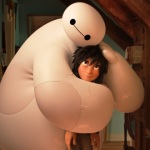Disney’s “Big Hero 6” looks too intense for my 4-year-old son to tolerate, but the trailer alone has made him (and me) enamored with Baymax. This robot is unlike any we’ve seen onscreen. His inflatable, soft limbs and belly remind us more of a balloon from the Macy’s Thanksgiving Day Parade than a device with a lithium-ion battery. But what makes him endearing goes beyond his outward appearance. Indeed, as I explore at Word and Film today, we’re learning that marrying a cute design with human quirks gives beloved film robots something akin to a soul.
Based on a Marvel Comics series, “Big Hero 6” shows the bond between Baymax (voiced by Scott Adsit of “30 Rock”), a teenage robotics prodigy named Hiro (Ryan Potter), and Hiro’s friends in San Fransokyo, a metropolis mash-up of Japanese and American culture. Designed as a nurse, Baymax diagnoses ailments with a nod, feels “like spooning a warm marshmallow” to one character, and readily dispenses lollipops and reassurance. But when a sinister manipulator of microbots appears, Baymax proves to be more than fluff; he and his pals step up to save the day with upgrades like protective armor and jet boots.
The film, opening November 7, is featured in this month’s issue of Wired magazine, which highlights the elements behind Baymax’s design. His face, with its dot eyes connected by a line, is based on a traditional copper bell in Japan and is a “simple canvas” for the audience to project its emotions, the filmmakers said. Diapered toddlers inspired his penguin-like waddle.
We don’t trust robots that look and act too human. Robotics professor Masahiro Mori coined a term for this unease in the 1970s: The moment when human empathy for robots turns to revulsion is the “uncanny valley.” But even decades earlier, science fiction stories toyed with this discomfort. The earliest-known robot in cinema, the Maschinenmensch of Fritz Lang’s 1927 film “Metropolis,” takes the face and form of a woman but has a nefarious mission. Gort, the robot from “The Day the Earth Stood Still” in 1951 (and later 2008), based on the Harry Bates story “Farewell to the Master,” has a rough humanoid form but blasts a destructive beam.
Learn where Baymax and other cinematic robots fall in this range by clicking here.

